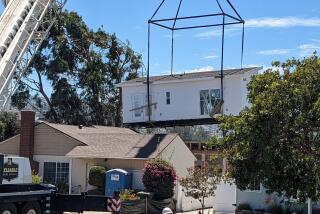New home loan helps lower-income borrowers build equity quickly

Grace and Armando Ong were among millions of Americans who lost their homes during the housing crisis.
Today, the Azusa couple are in the vanguard of borrowers taking advantage of a new loan that helps lower-income borrowers build equity fast — and protects them against any future crash in values.
All with no down payment, no closing costs and no mortgage insurance. The Ongs’ real estate agent, Jill Medley, called it “the best loan in the history of real estate.”
The key feature of the so-called wealth-building home loan is a sharply reduced interest rate on a 15-year term. Instead of requiring a down payment, banks allow borrowers to use their money to pay interest upfront, often called “buying down” the rate.
For their $400,000 house, the Ongs used what would have been a 4% down payment — $16,000 — to instead buy down their rate to 0.5%. In little more than three years of monthly payments, the couple will have more than 20% equity in the home, assuming the property value stays the same.
That more than doubles the equity they would build with the same amount down on a 30-year Federal Housing Administration loan at the going rate of 3.25%.
The Ongs pay only about $150 more each month than they would have paid under the longer-term loan, which would include a hefty mortgage insurance payment.
“The American dream is a reality,” said Grace Ong, a registered nurse at an area hospital.
The loan was unveiled in September by Edward J. Pinto and UCLA researcher Stephen D. Oliner, resident fellows at the conservative-leaning American Enterprise Institute. A key liberal housing advocate, Bruce Marks of the Neighborhood Assistance Corp. of America, or NACA, joined with them to promote the loan.
The new loan aims primarily to help low- and moderate-income borrowers seeking to buy modestly priced homes. They cannot own any other property and are required to live in the one- to four-unit properties that they purchase.
In Southern California, the NACA program sets a maximum price of $400,000 for a single-family home, and $697,696 for a four-family property, so most purchases would be in lower-priced inland areas. Wealthier folks could get the loan, but they would have to buy and live in the low- or moderately priced neighborhoods.
The loan can benefit banks as well as home buyers.
In a NACA program, for example, Bank of America and Citibank chip in subsidies to fulfill their obligations under the 1977 Community Reinvestment Act to provide affordable funding to modest- and low-income borrowers.
The banks have put a total of $13 billion into a program to offer discounted mortgage rates, now including 15-year as well as 30-year loans. Citibank offered the Ongs, who were NACA clients, the $400,000 wealth-builder loan at 2.5% and allowed them to buy down the rate.
Even without the rate subsidies, however, the inventors of the new mortgage believe that the wealth-building effect is still enormous and attractive to many borrowers and bankers.
“The 15-year loan is an equity-generating machine, which makes a down payment unnecessary,” said Pinto, a former official at mortgage financing giant Fannie Mae and co-director of the institute’s Center on Housing Risk.
Oliner said rapid equity growth is especially desirable in volatile real estate markets such as California’s, where soaring home prices dropped like a rock in the early 1990s and again during the recession, leaving millions of borrowers underwater, or owing more on their mortgages than their homes were worth.
Marks called the 15-year loan a “game changer” — a way for his minority and low-income clients to be free of housing debt by the time their children go to college or they retire.
The loan is not for those who can’t afford somewhat higher monthly payments, nor may it appeal to borrowers who want to lower their taxable income with interest deductions. But for those who don’t benefit much from writing off the mortgage interest, and even for some who do, the equity-building loan could be a great deal.
Good candidates include many people in their 20s looking to buy a first home. They would do better, Pinto said, to buy a smaller house on a 15-year term than stretching for a bigger house and spreading the payments over 30 years.
“After five to seven years, their income should grow, and they’ll have enough equity to trade up to a larger house to raise their young families,” he said.
If they finance that second purchase with a new 15-year loan, they may pay it off in time to use the extra money for their children’s college expenses.
Pinto has been promoting the loans jointly with Marks, a housing activist known for disrupting bankers’ neighborhoods and stockholder meetings with noisy protests. The odd couple said they realized during a joint appearance at a housing forum that they agreed on the desirability of loans that build wealth quickly.
For years, NACA staffers helping applicants for 30-year mortgages have put them through a wringer of financial counseling and budget analysis to get loans, a process that can take months and even years.
NACA, which started making the 15-year loans this fall, will continue doing so for years, Marks said, noting that Bank of America and Citi have $8 billion remaining of their $13-billion commitment.
The kind of careful underwriting and counseling available now was sorely missing during the housing boom a decade ago.
The Ongs, who came here from the Philippines in 2004, got caught up in the housing frenzy two years later. They bought a $680,000 house in Pomona and paid $4,400 a month. The house fetched $330,000 when they lost it in a short sale in 2012.
The couple said they learned their lesson. Since Armando Ong is 60 and Grace Ong is 57, they plan to make extra payments on their new loan with the goal of paying it off in seven years instead of 15.
Housing advocates lauded the NACA program but expressed skepticism that its highly favorable terms could be widely duplicated.
Broader adoption to benefit lower-income borrowers “would require subsidies from someone — buy-down assistance from the government or nonprofits,” said Michael Calhoun, president of the Center for Responsible Lending in Durham, N.C.
Without significant assistance, he said, many low-income borrowers simply won’t be able to make the higher payments.
“We’ve run the numbers on modest houses,” Calhoun said. “Fifteen-year loans add hundreds of dollars to monthly payments, and most people are pretty stretched on their monthly expenses already.”
Oliner and Pinto said they are having discussions with about 20 institutions — lenders, insurers, investment firms, nonprofits — to make the discounted 15-year loans widely available to borrowers of all income levels.
OneWest Bank in Pasadena, which is awaiting regulatory approval for a controversial merger with New York business lender CIT Group, has said it’s considering making the loans to satisfy the Community Reinvestment Act.
And a Maine community bank has started making no-down-payment mortgages at unsubsidized rates. Androscoggin Savings Bank of Lewiston had closed two of the 15-year loans and had four or five more in its pipeline in mid-December, said Joseph Ferris, Androscoggin’s vice president for mortgage lending.
Borrowers pay 3% of the loan amount to Androscoggin to receive a 1.75% fixed interest rate the first seven years. The rate rises to 5% in years eight through 15.
“We’ve got real estate agents up here begging to come talk to us about it,” Ferris said.
Twitter: @ScottReckard
More to Read
Sign up for Essential California
The most important California stories and recommendations in your inbox every morning.
You may occasionally receive promotional content from the Los Angeles Times.







